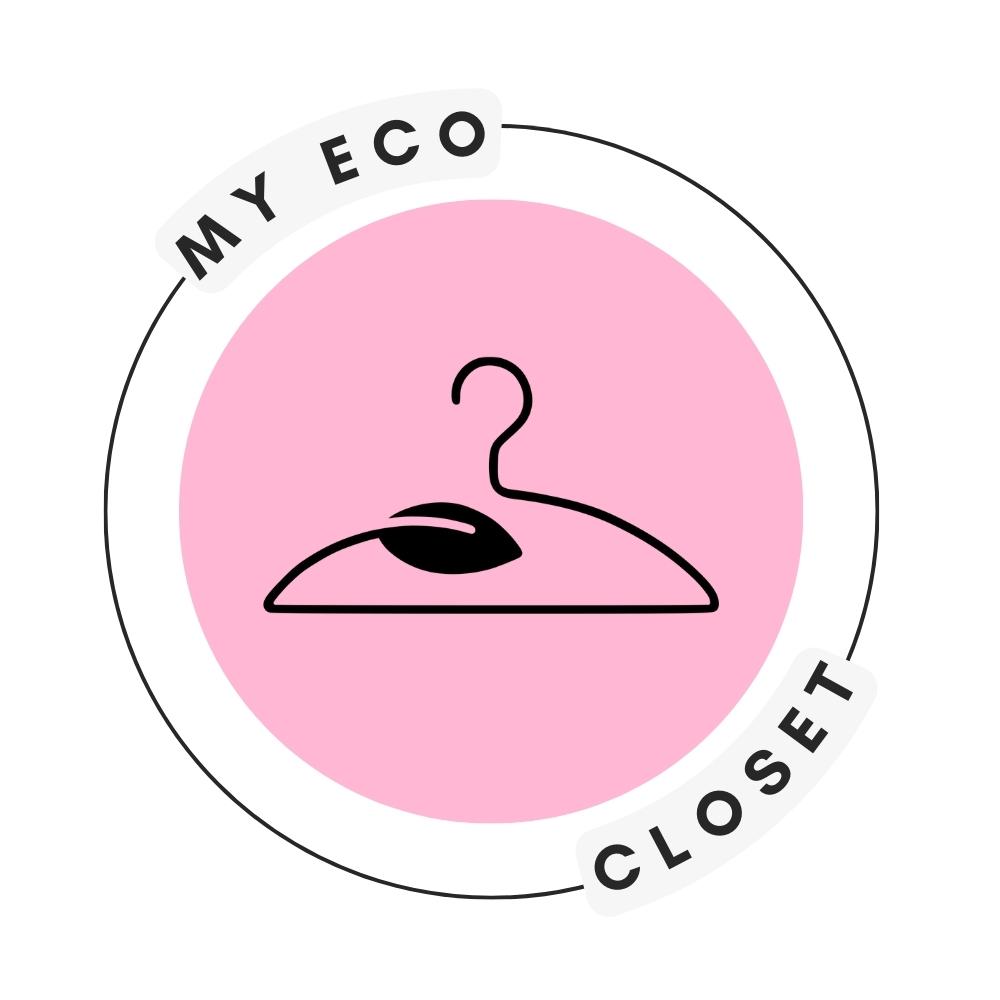The art of color season analysis has transformed countless wardrobes and boosted confidence through strategic color choices. This guide delves deep into two of the most commonly confused seasonal color categories: Spring and Summer. While both can feature light and delicate colors, understanding their distinct characteristics will revolutionize your approach to personal style.
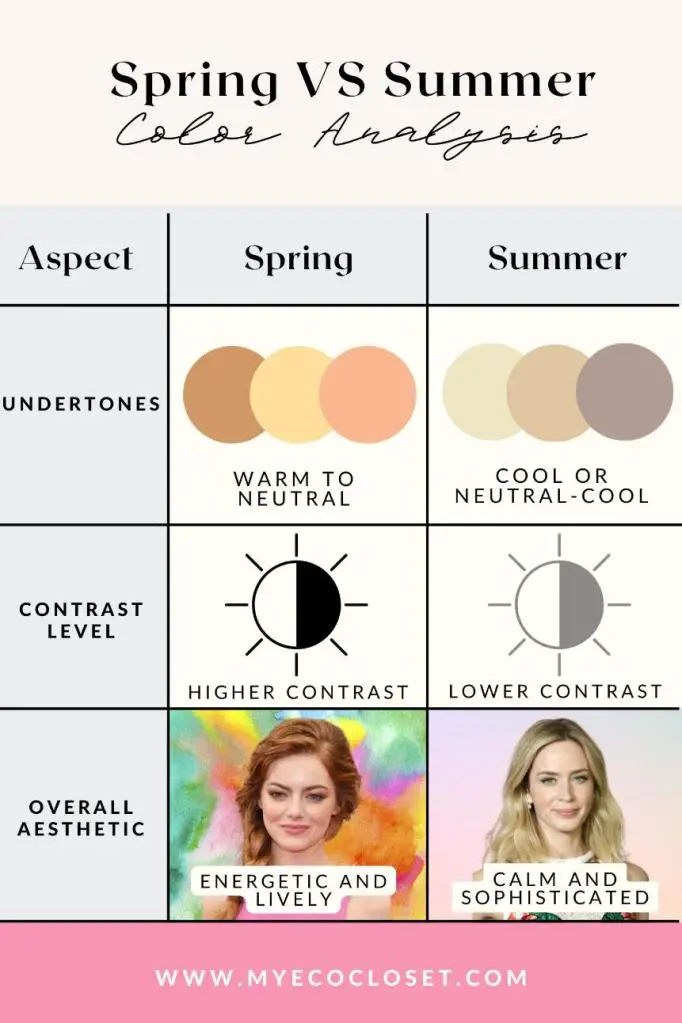

What Is Spring Color Analysis?
Spring palettes are characterized by warmth, brightness, and clarity – much like the season itself. Imagine the first blooms of daffodils, the fresh green of new leaves, and the warm sunshine of a spring morning. This is exactly what the spring palette embodies.
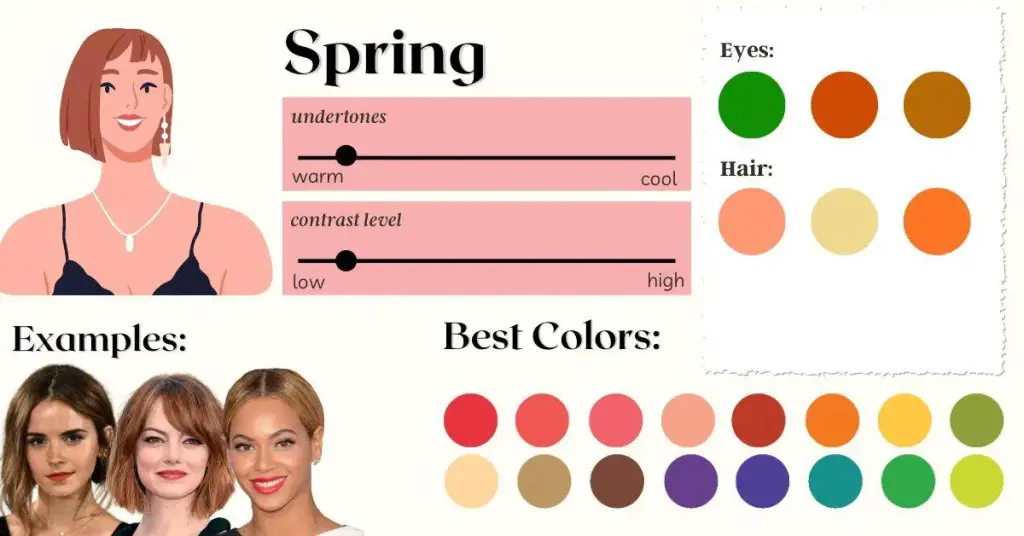
The Spring Complexion
The hallmark of Spring skin is its golden warmth and remarkable clarity. Unlike the cool, rosy undertones of Summers or the olive hints of Autumns, Spring skin carries a distinct peachy-golden glow. Key characteristics of Spring skin include:
- Golden or peachy undertones
- Translucent quality that appears lit from within
- Clear, bright appearance without any grayish or olive cast
- Tendency to flush coral or peach, rather than pink
- Often features delicate, golden freckles
- Burns easily but usually recovers to a warm golden tone
Spring Eye Colors
Spring eyes possess an unmistakable sparkle. Like dewdrops catching morning light, Spring eyes have a bright, clear quality regardless of their specific color. The whites of the eyes are typically very clear and bright, creating a striking contrast with the iris. Distinctive Spring eye colors include:
- Aqua blue – like tropical waters
- Golden-flecked green – reminiscent of new leaves in sunshine
- Warm hazel or amber – similar to honey or topaz
- Light to medium brown with golden undertones
- Clear turquoise
- Bright green with golden flecks
Spring Sub-Categories
The Spring palette is divided into four distinct sub-categories, each with its unique characteristics while maintaining the underlying Spring qualities of warmth and clarity. Understanding these nuances helps you pinpoint exactly which colors will work best for your particular combination of features.

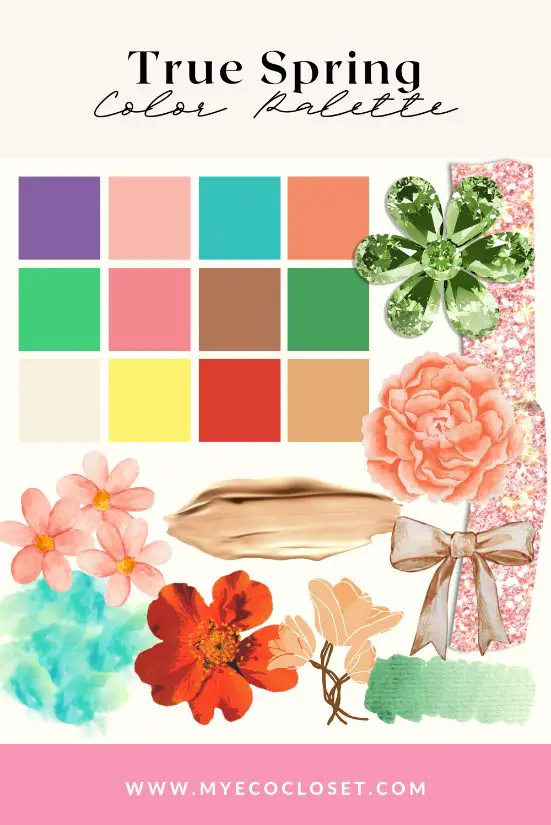
True Spring
The epitome of Spring characteristics, True Spring individuals radiate warmth and vitality. Think of the golden light of a perfect spring morning – this is the quality True Springs naturally possess. Their coloring is clear and warm, without any subtle undertones to muddy the waters.
- Warm, golden undertones that give skin a peachy glow
- Eyes that sparkle in bright blue, clear green, or light hazel
- Hair colors ranging from light blonde to medium golden brown
- Often has freckles or easily tans

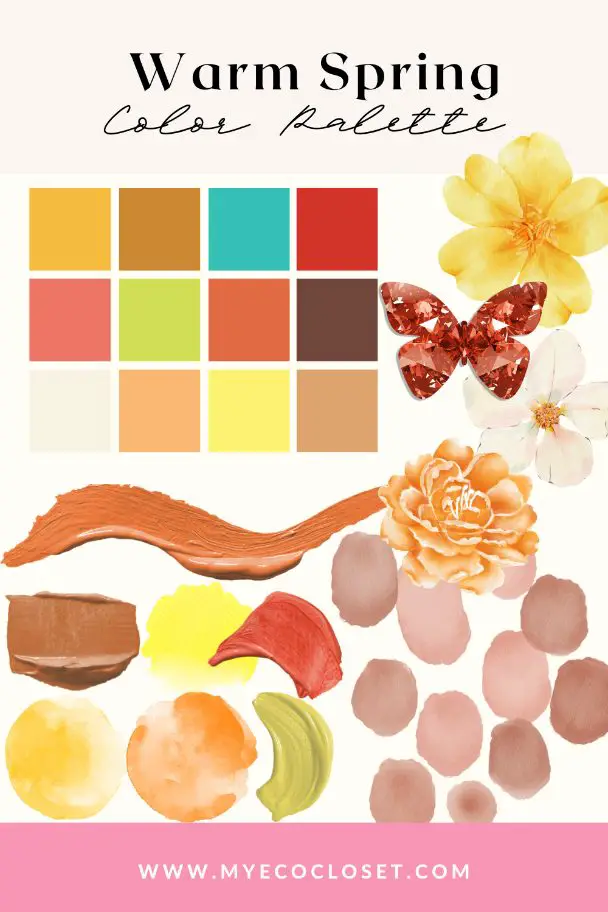
Warm Spring
Warm Spring represents the most sun-kissed and golden variation of the Spring family. These individuals often stop traffic with their naturally vibrant coloring, featuring hair that can look like it’s lit from within and skin that seems to radiate warmth. The following are the key features of this season:
- Warm Spring eyes tend toward the warmer end of the spectrum – rich amber, golden green, or warm brown
- Their hair can range from rich golden blonde to copper red or warm chestnut
- Representatives of this season shine in rich, warm colors, such as bright orange, golden yellow, and warm red, that overwhelm other Springs

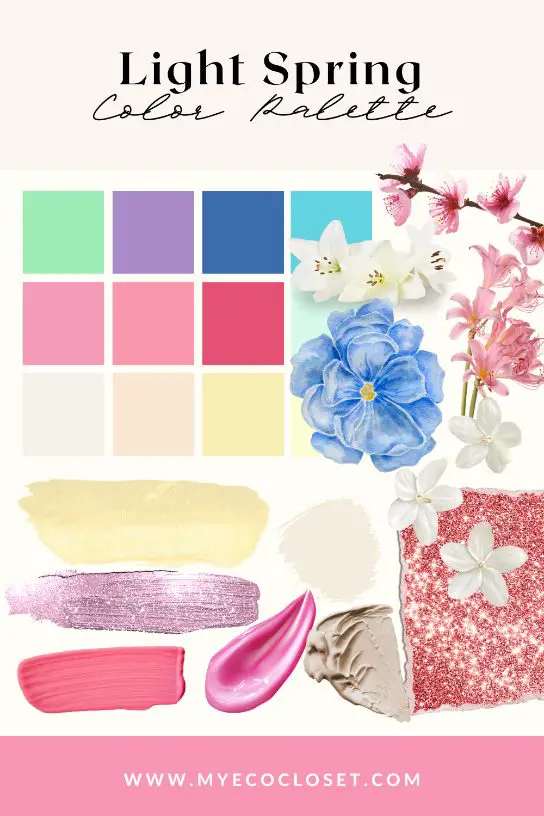
Light Spring
Light Spring combines the characteristic Spring warmth with a delicate, ethereal quality. These individuals often appear as if bathed in morning light – their coloring has a transparent quality that sets them apart from other Springs. Here are some of the key features of this color season:
- Light Springs typically have very fair but carry warm, rather than pink undertones
- Their eyes are often light and clear – think pale blue, aqua, or light golden brown
- Their hair tends toward light golden blonde or light warm brown
Their optimal palette reflects this softness while maintaining Spring’s inherent warmth. Soft coral, light turquoise, and warm pink all complement their natural coloring beautifully. Their neutral colors stay light and warm – light camel, warm beige, and soft gold provide the perfect foundation for their wardrobe.


Bright Spring
Bright Spring is where warmth meets drama. These individuals often have the most striking appearance among springs, with the highest contrast in their natural coloring, which sometimes leads to confusion with winter seasons. Here are the most important features of the Bright Spring sub-season:
- The Bright Spring complexion maintains Spring’s clarity but can appear more neutral
- Their eyes (usually bright blue, clear green, or light brown in color) and hair tend to create a dramatic contrast
- Their hair can range from golden blonde to dark golden brown, sometimes appearing almost black but with a warm undertone

What Is Summer Color Analysis?
Summer palettes embody the soft, cool sophistication of a misty summer morning. These colors are characterized by their subtle undertones and gentle contrast levels.
Summer Sub-Categories
The Summer family branches into three distinct sub-categories, each maintaining the core Summer characteristics of coolness and softness while offering unique variations. These subdivisions help Summer individuals fine-tune their color choices for maximum impact.


True Summer
True Summer embodies the purest expression of Summer characteristics, embodying pure coolness without any warm undertones. These individuals possess a naturally cool beauty that resonates with the soft, blue-based colors of their palette. Their coloring is like a watercolor painting – subtle, blended, and harmonious.
Key characteristics of True Summers include:
- Natural hair colors range from cool medium brown to ash blonde, often with no warmth or red undertones
- Eyes are typically cool-toned – soft blue, grey, or cool brown
- Skin has a distinctly cool undertone with no golden or peachy qualities
- Overall appearance shows medium contrast levels without any sharp distinctions

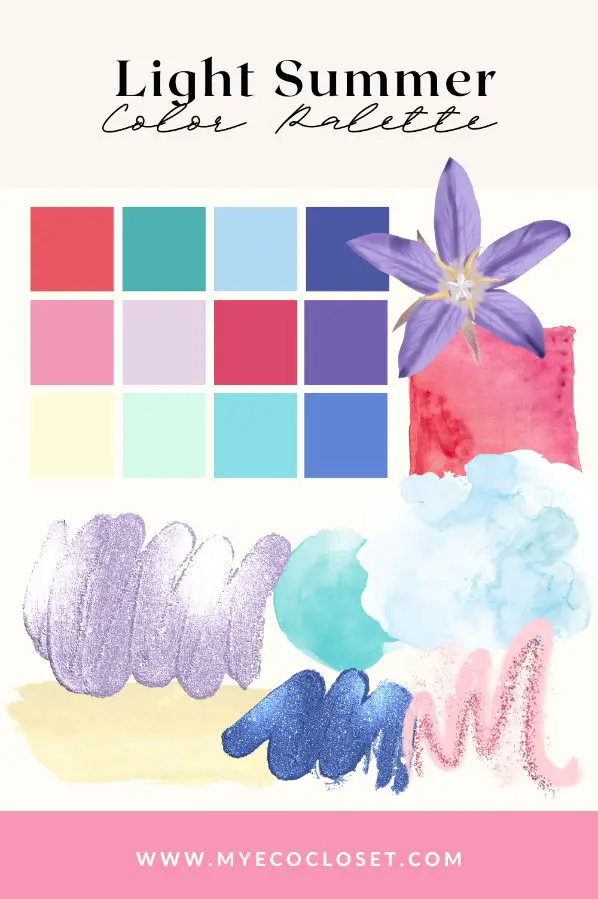
Light Summer
Light Summer represents a delicate merger between Summer and Spring characteristics, though still maintaining its primary cool undertone. These individuals often possess an ethereal quality, as if their coloring has been lightened by summer sunshine. That is to say, their natural coloring is low in contrast but distinctly cool.
The following are some of the most distinctive features of the Light Summer sub-season:
- Hair typically ranges from light ash brown to baby blonde
- Eyes are usually light – pale blue, grey-blue, or light grey-green
- Skin tone is fair with cool or neutral undertones
- Overall appearance shows low contrast but with a brightened quality

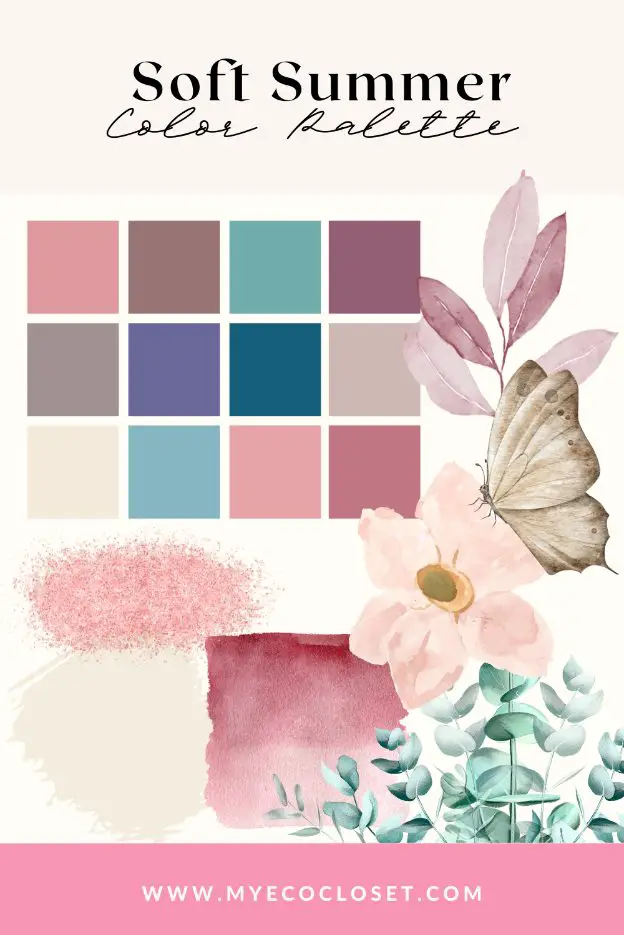
Soft Summer
Soft Summer demonstrates the most muted version of Summer coloring, where coolness meets a whisper of warmth. These individuals often present a graceful, understated appearance that’s enhanced by colors sharing their inherent subtle complexity. Their coloring appears slightly smoky or greyed, which is what makes this sub-season stand out.
The Soft Summer color season is distinguished by the following:
- Hair colors tend toward mousy brown or soft ash tones
- Eyes are often mixed colors – grey-green, hazel, or soft brown
- Skin shows neutral to cool undertones with a muted quality
- Overall appearance has low contrast with a softened effect

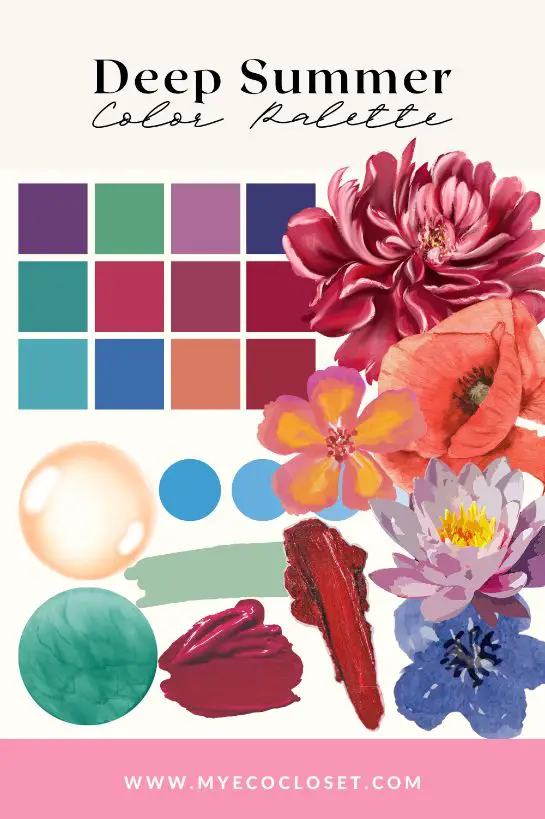
Deep Summer
Deep Summer represents the most dramatic variant within the Summer family, combining coolness with depth and intensity. These individuals maintain the characteristic Summer coolness but present it in a more concentrated form. Their coloring suggests drama while retaining the muted nature of the Summer season.
Notable traits of the Deep Summer sub-season include:
- Hair is typically dark ash brown to soft black Eyes are usually deep – dark blue, dark brown, or deep grey
- Skin can range from fair to medium with cool undertones
- Overall appearance shows higher contrast than other Summer types

Summer vs Spring Color Analysis: The Undertone Test
When it comes to deciphering whether you’re a Spring or a Summer, the key lies in your natural undertones. This factor is important enough to dictate your unique capsule wardrobe color palette, as it outlines whether you have an overall cool, neutral or warm undertone, which in turn, helps you unlock your most flattering color season.
Spring’s undertones are characterized by a radiant, golden glow — think corals, sunny yellows, and peaches — while the Summer palette features cooler, blue-based hues. To find out which undertone you carry, conduct the following test:
How to Perform the Wrist Test
- Find Natural Light: Begin by finding a well-lit area, ideally with natural light. This will provide the most accurate view of your skin’s true tone.
- Look at Your Veins: Examine the veins on the inside of your wrist. Make sure your skin is clean and free from any self-tanner or bronzer, as these can skew the results.
- Identify the color of your visible veins: If your veins appear predominantly blue, you likely have cool undertones. However, if they look more greenish, you probably have warm undertones. If they seem to be a mix of blue and green, or are simply difficult to categorize, you may have neutral undertones.
Once you’ve conducted the wrist test, you can find out where you stand in the summer vs spring color analysis. With blue veins and hence, cool undertones, you would belong to the Summer color season. Whereas, if your veins have a greenish tint, you would be classified as a Spring.
But what if your undertones are neutral? In that case, the lipstick test can be a revealing way to determine your color season.

The Lipstick Test for Spring VS Summer Color Analysis
Many people fall into the so-called “neutral zone”, where their undertones aren’t distinctly warm or cool, making it challenging to determine their true season. The lipstick is particularly useful when traditional indicators, such as hair and eye color, aren’t giving you a clear answer.
This test works by using carefully selected lipstick shades to reveal how your skin reacts to different color temperatures and intensities. To get started, you’ll need to gather specific lipstick shades that represent both Spring and Summer palettes.
Spring lipsticks can include bright coral, warm peach, or vibrant warm pink – all clear, warm shades that characterize the Spring palette. For Summer, select soft rose pink, muted plum, or gentle mauve – colors that embody the soft, slightly cooled undertones.
To perform the test, begin by gathering your test colors in a well-lit area with natural light, and follow these steps:
- Remove all makeup completely
- Pull hair away from face
- Stand in natural daylight (near a window is ideal)
- Wear a white or gray shirt to avoid color interference
- Have a makeup remover or wipes ready between tests
Step-by-Step Testing Process:
- Apply the first Spring lipstick directly to clean lips
- Step back and observe your whole face for 30 seconds
- Notice how the color affects your skin tone, eye brightness, and overall appearance
- Remove completely and wait 1 minute before trying the next shade
- Repeat with each Spring and Summer shade
- Take photos in natural light with each color for comparison
Interpreting Your Lipstick Test Results
When interpreting your lipstick test results, focus on how your skin responds rather than your personal color preferences. Spring types glow in bright corals – their skin looks fresh and eyes sparkle. Summer beauties shine in soft roses – these muted shades create natural harmony while bright colors might overwhelm.
Pro Tip: if the lipstick appears to sit “on top” of your coloring rather than blending seamlessly, it’s likely the wrong season for you.
Frequently Asked Questions
To determine whether you’re a Spring or Summer, look at your undertones. Springs have warm, golden undertones, while Summers have cool, blue-based ones. You can use tests like the wrist test (vein color) or the lipstick test to identify which palette suits you best.
Summer is based on cool, soft hues like pastel blues, pinks, and lavenders, reflecting the gentle, muted colors of a summer morning. Unlike Spring, which embraces warmth and clarity, Summer emphasizes coolness and subtle undertones, creating a harmonious but less vibrant look.
While Spring and Summer are distinct color profiles, individuals with neutral undertones may find their features align with both seasons. These people can fall into the “neutral zone” and may be able to wear colors from both Spring’s warm palette and Summer’s cool tones, though the balance may vary.
Eye clarity plays a significant role in determining your season. Clear, bright eyes with little to no gray or olive tint are often associated with Spring. In contrast, more muted or softer eyes, such as cool grey or hazel tones, often fit within the Summer palette.
Freckles and a sun-kissed complexion are often associated with Spring, particularly Warm Spring. Freckles give a golden, peachy glow to the skin, enhancing the vibrancy of Spring colors like coral and bright yellow. Summers, on the other hand, tend to have cooler undertones with little to no golden or freckled appearance.
